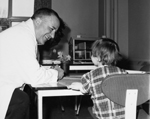| Home > Browse Selected Topics > Famous Canadian Physicians | Français | |
 
 Dr. Gustave Gingras devoted his life to people with physical disabilities, helping them to overcome their disabilities and to lead fulfilling lives. He was both a national and international pioneer in the specialty of physical and rehabilitation medicine.  Source Gingras was born in 1918 in Montréal. He followed a classical education at College Bourget in Rigaud, Quebec, where he obtained a BA in 1936. Following graduation, he entered the Faculty of Medicine at the Université de Montréal and received his MD in 1941. Off to warBy the time Dr. Gingras had completed his studies, war was raging in Europe, so he decided to join the Royal Canadian Army Medical Corps. He had chosen to intern in neurosurgery and was posted to the Canadian Neurosurgical and Plastic Surgery Hospital in Basingstoke, England. "Working closely with such dedicated professionals was the best medical training of my career," he said.  Source When he returned to Canada, Dr. Gingras intended to continue working in neurosurgery. But a conversation with the Montréal neurosurgeon Dr. Wilder Penfield changed his plans. Penfield asked him to coordinate the rehabilitation of a group of 50 veterans who were recuperating at the Ste. Anne de Bellevue Hospital in Montréal. The patients all had paraplegic or quadriplegic impairments as a result of war wounds, and expected to spend the rest of their lives as invalids. Dr. Gingras gathered a team of physical and occupational therapists, social workers and psychologists; together, they pioneered many rehabilitation techniques. The team helped rehabilitate many of the 50 handicapped veterans and enabled them to return to their homes and jobs. This was the start of Gustave Gingras's career in physical medicine and rehabilitation. 



Source 



Source Birth of the Montreal Rehabilitation InstituteBy now, Dr. Gingras had also begun working with non-military patients from the private sector. He opened his first clinic in a small room of an old hotel in Montréal and welcomed patients two afternoons a week. As the demand grew, it became clear that he needed larger facilities; in 1949, he founded the Rehabilitation Institute of Montreal and was its executive director until his retirement in 1977. During this period, he also served as the first professor of Physical Medicine and Rehabilitation at the Université de Montréal. The Rehabilitation Institute quickly became the most important centre for rehabilitation work. One of its most notable accomplishments was the establishment of a prosthetic and orthotic workshop and laboratory for children with physical disabilities. Timely helpFortunately, the Institute was in full swing in the 1950s when a polio epidemic struck; Gingras and his medical team were ready and able to offer help to those affected. Similarly, in the 1960s, when hundreds of babies were born with their limbs affected by the drug thalidomide, Dr. Gingras coordinated the treatment and rehabilitation of many in Quebec and the Atlantic provinces.  Source Gustave Gingras assisted many other nations as well as Canada. In 1953, the United Nations sought his help in the rehabilitation of some 10,000 victims of work-related accidents in Venezuela, a situation that had stemmed largely from that country's recent oil boom. Gingras set up training programs for local personnel and set in motion the establishment of rehabilitation centres. Also at the request of the United Nations (UN), he visited other South American countries, such as Brazil, Argentina, Chile, Bolivia and Colombia, to assess their needs for rehabilitation and help set up appropriate programs. Disaster in MoroccoIn 1959, the League of Red Cross Societies and the World Health Organization contacted Dr. Gingras when a mysterious disease struck the Moroccan city of Meknes. Eventually it was discovered that the paralysis affecting as many as 10,000 Moroccans had been caused by motor oil sold and consumed as cooking oil. There was no known cure except to retrain damaged muscles. Skillfully coordinating a rescue team from 21 countries, Gingras enabled 8,000 of the victims to make a full recovery. In 1965, the Canadian International Development Agency (CIDA) asked Dr. Gingras to travel to South Vietnam to coordinate the rehabilitation of wounded victims of the Vietnam-American War. There, he helped set up workshops to build and fit prosthetic devices. Canadian Hugh Keenleyside, who headed the UN team, noted: "Gingras was a man remarkable for the depth of his human spirit as he was for his technical skills and his organizational genius. As a result of the establishment of these workshops, hundreds of Vietnamese were given a renewed capacity to live useful and productive lives." Three years later, again at the request of CIDA, Dr. Gingras undertook a mission in the African country of Cameroon to build rehabilitation centres and establish training programs. Committed lobbyist Source  Source  Source Throughout his life, Dr. Gingras was a strong advocate for the rights of people with disabilities. He energetically lobbied government and social institutions to provide access and facilities to people with disabilities and for legislation that would integrate them into both employment and the public school system. Dr. Gingras was also responsible, in 1964, for perfecting the workings of the artificial human hand activated by the body's own electrical impulses. After his retirement in 1977, Gustave Gingras moved to Charlottetown, Prince Edward Island, to take charge of rehabilitation services for the Prince Edward Island Department of Health. He also served as Chancellor of the University of P.E.I. from 1974 to 1982. For several years, he lobbied, along with the War Amps of Canada, to gain special compensation for Canadian veterans who were taken prisoner by the Japanese in Hong Kong in 1941. He also lobbied to obtain compensation for thalidomide victims of the early 1960s. Gustave Gingras received dozens of honours for his work in rehabilitation. He was made a member of the Canadian Hall of Fame, a Companion of the Order of Canada and a Companion of the Order of Malta, among many other recognitions.  Source In the last years of his life, Gustave Gingras suffered from a degenerative neurological disorder. Nonetheless, he himself practised the most important lesson he had given others: "Never give up and focus on remaining abilities rather than on those lost." He died at his ocean-side home in Prince Edward Island in 1996. |